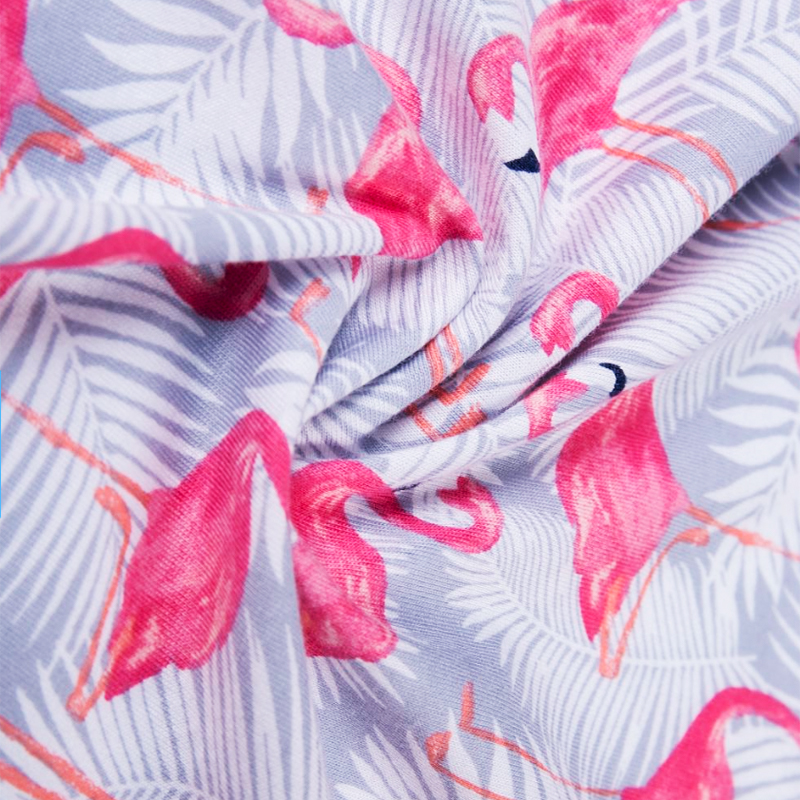The weight of Jersey Clothing Fabric plays a significant role in determining its suitability for various clothing items, as it affects both the comfort and appearance of the garment. Here's how the weight influences its use:
1. Lightweight Jersey Fabric
-
Characteristics: Lightweight jersey fabric typically weighs between 100-150 grams per square meter (gsm). It’s thin, soft, and drapes well, making it ideal for casual and warm-weather garments.
-
Applications:
-
T-shirts and Tops: Lightweight jersey is commonly used for comfortable t-shirts, tank tops, and blouses. The soft, breathable fabric provides comfort for everyday wear.
-
Dresses and Skirts: Lightweight jersey is great for dresses and skirts with a more fluid, relaxed fit. The drape of the fabric contributes to the flowy and flattering silhouette.
-
Loungewear and Pajamas: Its softness and lightness make it a popular choice for loungewear and sleepwear, offering comfort without excess weight.
-
-
Advantages: The light weight allows for breathability and moisture-wicking properties, making it suitable for warmer climates or as a base layer under other clothing.
-
Considerations: While it is comfortable, lightweight jersey may be more prone to sheer or see-through effects, especially in lighter colors, and may stretch out of shape more easily with wear.
2. Medium-Weight Jersey Fabric
-
Characteristics: Medium-weight jersey typically weighs between 150-200 gsm. It offers a bit more structure compared to lightweight jersey while maintaining a smooth, comfortable fit.
-
Applications:
-
Casual Dresses: This weight is perfect for creating dresses with more defined shapes, like shift dresses or bodycon styles, that still offer stretch and comfort.
-
Tops and Tunics: A medium-weight jersey is commonly used for long-sleeve t-shirts, tunics, and casual blouses, offering more durability and opacity than lightweight fabrics.
-
Activewear: It is often used in sportswear or athleisure for items such as leggings, hoodies, and track pants, offering a balance of stretch, comfort, and support.
-
-
Advantages: Medium-weight jersey provides a good balance of stretch and durability, making it versatile for a wide range of garments. It also holds its shape better over time compared to lighter fabrics.
-
Considerations: Although it’s versatile, the slightly heavier weight can limit its use for more delicate or lightweight garments like summer dresses.

3. Heavyweight Jersey Fabric
-
Characteristics: Heavyweight jersey fabrics weigh 200 gsm or more. This fabric is thicker, denser, and has more structure, offering a more substantial feel.
-
Applications:
-
Sweatshirts and Hoodies: Heavyweight jersey is the go-to fabric for creating warmer clothing like sweatshirts, hoodies, and jackets. Its thickness provides warmth while maintaining the stretch properties of jersey.
-
Pants and Leggings: Heavyweight jersey is often used for leggings that require more support and durability, especially in athletic wear or winter wear.
-
Outerwear: Some coats and jackets use heavyweight jersey for a more structured appearance and greater insulation.
-
-
Advantages: It offers warmth and durability while maintaining a comfortable, stretchy fit. It's ideal for cold-weather clothing or items that require a bit more structure.
-
Considerations: Heavyweight jersey fabric can be less breathable than lighter options, which can make it less suitable for warm weather garments. It also requires careful handling to prevent stiffness or bulkiness in the final garment.
4. Impact on Drape and Fit
-
Lightweight jersey has a soft drape, making it ideal for garments that require movement or flow. It’s perfect for styles that emphasize a relaxed, casual fit.
-
Medium-weight jersey provides more structure, which can create garments that hold their shape but still offer comfort and flexibility. It works well for garments that need a bit of tailoring or defined shape.
-
Heavyweight jersey has the most substantial drape and can be used to create garments with more structure and stability. It’s excellent for designs that require a more defined fit or warmth.
5. Care and Maintenance
-
Lighter jersey fabrics may require more gentle care, as they are more prone to snags or stretching. Heavyweight jerseys may stand up to more rigorous washing and handling but could feel stiffer after washing if not cared for properly.


.jpg?imageView2/2/format/jp2)








